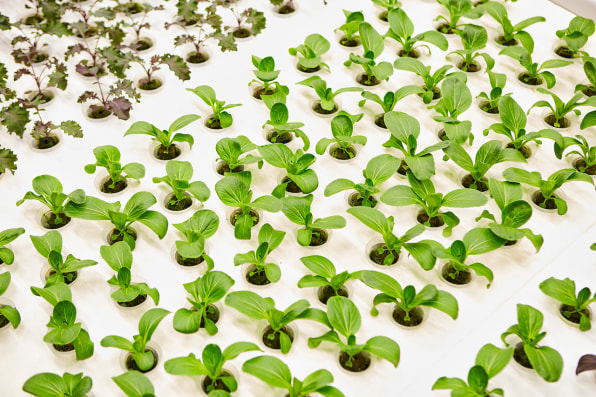by Adele Peters: Iron Ox’s robots are currently planting, growing, and harvesting lettuce in a California warehouse…

Inside a former commercial warehouse in San Carlos, California, a robotic arm is carefully transplanting tiny sorrel plants from one large tray to another. In another corner of the room, a larger robot sits ready to carry other trays–filled with romaine lettuce, bok choy, cilantro, and more than two dozen other types of greens–over to the robotic arm. At the moment, there are no people in the room: This is the headquarters of Iron Ox, which bills itself as the world’s first fully autonomous farm.
“We designed the entire process, from the beginning, around robotics,” says Iron Ox co-founder and CEO Brandon Alexander, who previously worked at X, Alphabet’s so-called moonshot factory, and the robotics lab Willow Garage. “It required us pretty much going back to the drawing board to see what we could do if robots were in the loop.”

The startup aims to make fresh, pesticide-free produce accessible everywhere. Like other indoor farms, it wants to grow greens locally to change the fact that spinach or lettuce often travels 2,000 miles to get to consumers. But it also wants to use the maximum amount of automation to make that local produce as affordable as possible.“We want to basically be the best head of lettuce but also at the best price point,” says Alexander. “We can make sure that we’re selling produce to places that don’t normally have access to produce. It’s not just food deserts in urban areas. There’s also places in a lot of rural America where there’s maybe only a Dollar General–they’re not doing fresh produce today.”
After testing earlier versions of its technology last year, the company has just begun running its first production farm. While some others working in indoor farming try to use space efficiently by stacking trays or growing crops on 20-foot-high vertical walls, this startup is using a different layout, with plants in flat tubs. The founders realized that they could save substantial costs and energy by growing with natural light instead of relying only on LED bulbs, so only a single layer of plants made sense. (In the current headquarters, they still use artificial light, but will soon move into a building like a more traditional greenhouse.)
A hydroponic growing system, with no soil, uses 90% less water than traditional farming. The robotic system saves labor costs, since the robots can handle planting crops, adding nutrients, transplanting the plants as they grow, and harvesting and packaging the greens for consumers; the whole system, down to the pots that hold plants, was optimized to work with robots. By moving the plants from tray to tray–with baby plants growing in a tightly spaced pattern–the system can also make use of limited room. In the current 1,000-square-foot farm, the startup says it can grow 26,000 heads of lettuce and other greens and herbs per year, or about 30 times more than could be grown in a one-acre outdoor farm.

The mobile robot uses sensors similar to a self-driving car to navigate the room, carrying 800-pound growing units back and forth to the robotic arm and other supplies like nutrients. While other indoor farms are increasingly also using extensive automation–also using robots to plant seedlings, water, trim, and harvest crops–Iron Ox says that its own farm, which also uses AI to learn and improve operations, is the first designed to be completely autonomous. (At the moment, as the technology continues to develop, humans are still involved with some steps in the process, like dosing plants with nutrients, but these will eventually transition to automation as well.) A cloud-based “brain” monitors the whole farm and directs the robots. The company’s team of plant scientists is working with its engineers to build algorithms for the robot to identify plant diseases. Ultimately, the farm can run completely on its own; plant scientists and roboticists will oversee the system, but aren’t necessary. Other indoor farming companies are taking somewhat different approaches. Aerofarms, which operates massive farms inside a former steel mill and a former paintball arena in Newark, New Jersery, also uses robotics heavily, but says that the process is a “science and an art” requiring farm technicians to provide quality assurance.

The upfront cost of Iron Ox’s technology is designed to be as cheap as possible, and Alexander says that in less than a year, produce sales will be able to cover the initial investment. Because the robotic system is mobile, it can also easily scale, unlike the conveyor belt system or other more traditional stationary factory equipment used by a Japanese robotic farm; if you want to grow more plants, you just add more trays, and the robot travels to them. The farm is still limited by space, but the robot allows it to avoid the expense of expanding fixed systems.
As the farm launches, it will initially sell its produce to restaurants. “The next step is to be working with chefs and say, ‘Hey, we’re your neighborhood robotic farm,’ and we want to supply probably the freshest produce they’ll ever have access to,” says Alexander. It will soon begin working with grocery stores, and in 2019, plans to begin expanding to other locations. The company eventually wants to grow produce that it can supply locally everywhere at a cost lower than any other alternative. “Ultimately, this needs to be something that could scale to midwestern Costcos or Walmarts,” he says.
Source: Fast Company

















































